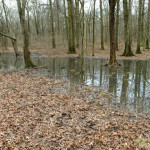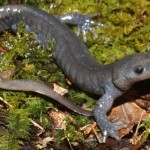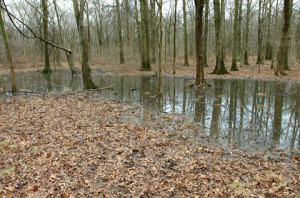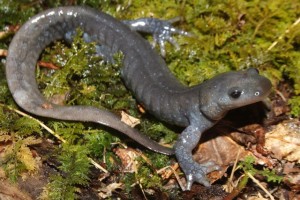- Vernal Pond
- Jefferson Salamander
- The Hikers
 It was a great day, a little windy, but you couldn’t ask for better weather and trail conditions. We even got to hike on moss! Just the week before the trails were covered in snow and ice making footing very precarious. The vernal pond was not frozen over making observation easy with no sign that the Jefferson Salamander had been there. It has not been quite warm enough yet for them to migrate. We also stopped at the non-vernal pond and had a little discussion about toads and frogs. There was a little excitement on the way back when one of the puppies got loose, but the kids made a mad dash and caught the dog.
It was a great day, a little windy, but you couldn’t ask for better weather and trail conditions. We even got to hike on moss! Just the week before the trails were covered in snow and ice making footing very precarious. The vernal pond was not frozen over making observation easy with no sign that the Jefferson Salamander had been there. It has not been quite warm enough yet for them to migrate. We also stopped at the non-vernal pond and had a little discussion about toads and frogs. There was a little excitement on the way back when one of the puppies got loose, but the kids made a mad dash and caught the dog.
At the vernal ponds we discussed their importance and how to recognize a vernal pond. Vernal ponds are usually found in depressions in the ground with trees on the edges, with a canopy present to keep the sun from reaching the pond. Vernal ponds are present in late winter and early spring and dry up during the summer months. They are generally less than 40 yards in diameter and no more than 4 feet deep. The water is usually a brownish color due to the tanic acid in the leaves that line the bottom of the pond. Some vernal ponds are present in the fall and are referred to as autumnal vernal ponds. The Joseph Ibberson vernal pond is autumnal.
Vernal ponds are harder to identify in the summer months when they are dried up. Look for the depression in the ground with little understory, blackened marks on surrounding tree trunks, compressed leaf litter, gray soil, water-marks on surrounding tree trunks and the presence of moisture-tolerant vegetation.
The seasonal nature of a vernal pond means they are not inhabited by fish, creating a perfect breeding ground for amphibians with less predation present. Species like the mole salamanders, wood frogs, and fairy shrimp depend exclusively on vernal ponds for part of their life cycles. Reptiles, birds and mammals depend on vernal ponds for food.
Vernal ponds are considered wetlands, are fascinating to observe , and essential to the lives of many woodland species. With the rapid population decline of so many amphibians species, it is crucial that these often unnoticed habitats be recognized and protected. It is believed that amphibians are good indicators of how healthy or sick the environment is since they breath through their skin and are extremely sensitive to pollutants.
The Jefferson salamander is the first creature to arrive at the vernal ponds. It is native to Pennsylvania and one of the largest salamanders. They can reach up to 8 inches in length, are bluish gray with blue specks and have long toes. Sometimes the Jefferson salamander is black in color. Jefferson salamanders are of the mole salamander species and spend most of their lives in underground burrows, under rotting logs, rocks and leaf litter.
On a warm rainy night from March to April they will travel an often snowy forest floor to reach their chosen vernal pond. Here they mate and lay their eggs. The males will lay sacks of sperm called spermatophores on submerged vegetation. The females pick up these sacks to complete internal fertilization. Eggs are laid in a day or two, in 20 gelatinous, clear masses containing up to 15 eggs each, which are attached to underwater vegetation or twigs. The young hatch in around 30 days and transform into land dwelling juveniles in two to four months. You can tell a Jefferson salamander larva from that of a frog or toad larva (tadpoles), because it has external gills, while a tadpole’s gills are internal. Jefferson salamanders are explosive breeders often coming out on the same night in large numbers returning to the same vernal pond each year.
Jefferson salamanders are carnivorous, meat eaters, and prey on a variety of small insects, grubs, and worms. The larva is also carnivorous, feeding on insect larva, fairy shrimp, and other small invertebrates.





